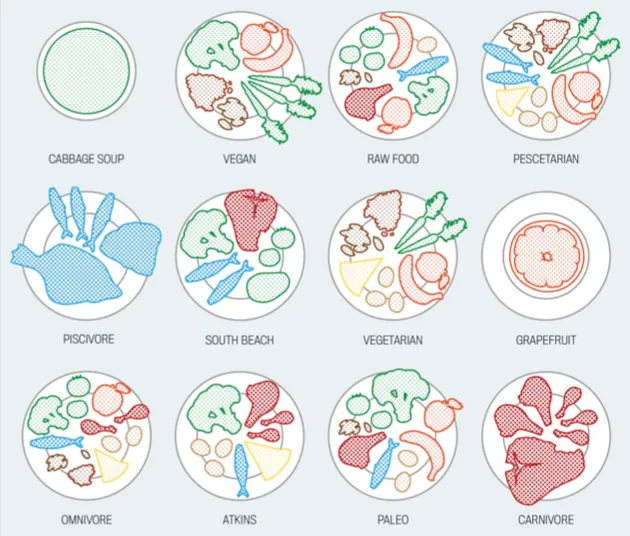Whether the post-Christmas blues have kicked in or your beer belly won't shift in time for summer, in the cold light of day; chances are you might be feeling less than happy with the shape of the person looking back at you. But salvation is only a Google search away in the comely form of the latest diet plan, featuring lithe 30-somethings brandishing forkfuls of grapefruit, or mums holding up enormous pairs of their old trousers. Not only will this diet help you slide effortlessly back into your skinny jeans, it’ll also brighten your skin, reduce your risk of cardiovascular disease and stop diabetes in its tracks. But are the diets du jour really as perfect as they claim to be? And are there any facts behind the fads?
Celebrity endorsement goes a long way to turning a diet idea into a diet trend, with or without scientific evidence. Take the Raw Food plan, beloved – allegedly – of the likes of Uma Thurman and Demi Moore. Heating your food destroys the nutrients and natural enzymes, which aid digestion and protect you from chronic disease, say raw food fanatics. So cooking food, in effect, ‘kills’ it. Followers of the diet make sure that around 75 per cent of their daily diet is made up of plant-based foods that haven’t been heated above 46°C (115°F). The diet purports to boost everything from your immune system to your memory, clearing up headaches and allergies, arthritis, diabetes and so on.
On paper, it makes perfect sense. When thrust into the fiery furnace of scientific scrutiny, however, the diet goes up in smoke. “The Raw Food diet has the least scientific evidence or reasoning behind it,” says Dr Scott Harding, lecturer in nutritional sciences at King’s College London. “There is no way that eating raw food specifically improves people’s antioxidant capacity or directly reduces their risk of developing chronic diseases.”
Scientific rationale might have made short work of raw food, but researchers have engaged more enthusiastically with other fashionable eating plans. Take the paleo diet, the most Googled eating plan of them all. By basing the diet on the supposed eating habits of our lean, disease-free hunter-gatherer ancestors, this plan promises weight loss, as well as a reduced risk of diabetes, heart disease and cancer. The rules: no processed food, sugar, dairy, grains or legumes, just foods that can be hunted, fished or gathered (eggs, nuts, seeds, fruits, vegetables, herbs, spices). It’s a compelling elevator pitch, but does the science stack up?

Paleo’s flaw is in its premise. As critics have pointed out, our digestive systems and food have evolved significantly in the past 10 millennia. Contrary to popular interpretations of caveman’s carnivorous and low-carb eating habits, evolutionary research suggests that our earlier ancestors feasted frequently on nuts, seeds, fruits and veggies rather than meat and fish. Stone Age humans would have eaten around 20 different types of plant-based foods a day, says Dr Mark Berry, senior research and development manager at Unilever, who led a 2010 study into the paleolithic diet.
“It has been interpreted as a low carb, no-grain diet – similar to Atkins – but the publicised form isn’t quite how it was,” says registered nutritionist and dietitian Sue Baic, co-author of Nutrition For Dummies. “Actually, the paleo diets had quite a lot of plant foods. The diets are characterised by low energy density, high fibre and large amounts of bioactive plant polyphenols.” It’s this broad spectrum of phytonutrients (compounds found in plants) that holds the key to its success.
Fill up on fruit
In Dr Berry’s study, volunteers were served either a plate of fish and rice with one portion of veg and one of fruit – a ‘healthy’ modern-day meal – or a paleo-inspired meal of fish and a variety of different fruits, vegetables, nuts and mushrooms. Those who consumed the paleo meal felt much fuller three hours after eating. They also had significantly higher levels of PYY, which is the hormone that tells us we’ve had enough to eat. While paleo isn’t perfect, it does have valuable elements. “Super-sizing fruit and veg will fill you up,” says Baic. “And very concentrated high-energy density foods that are high in fat and sugar need to be kept more as treats.”

The other problem with paleo in its popularised form, says Baic, is that cutting out a food group, like grains, doesn’t just unbalance your diet, it also makes it more difficult to sustain. “Low-carb diets and the so-called paleo are difficult to follow, while macrobiotic and raw diets just aren’t sensible,” she says. Your diet needs to be realistic if it’s going to be successful. If it’s realistic, it’s likely to be more sustainable, and sustainability is a cornerstone of the ‘perfect’ diet plan. “The majority of evidence shows that most diet approaches work if people can follow them,” says Baic.
Not so fast
Enter the 5:2 diet, which offers five days of normal eating “with little thought to calorie control” to every two days of near fasting, when you eat a quarter of your recommended daily calorie quote. This works out as 500 calories for women and 600 for men. Not only is the concept of 5:2 easy to grasp, it’s also a less punishing regime to follow. Got a client dinner or a birthday lunch? No problem, you won’t fall off the wagon. “From this point of view, the 5:2 diet is very good,” says Baic. “There’s good evidence to support it. It’s not for everyone – say, if you’ve got a history of eating disorders or diabetes, or you’re pregnant or breastfeeding – but generally it fits in with modern life. Psychologically, you know you’re not depriving yourself every day.”
However, research published in The American Journal Of Clinical Nutrition in July 2005 showed that for long-term weight-loss success, a consistent diet approach was more successful. Participants who reported a consistent diet across the week were 1.5 times more likely to maintain their weight within 2.2kg over the next year than those who dieted more strictly on weekdays. So it might work in the short term, but consistency, it seems, will keep you in the healthy eating game for the long haul. And a 2014 review by researchers at the University of Illinois found that daily calorie restriction is still a more effective means of losing weight than fasting.
The key to the perfect weight-loss diet is calorie restriction. “The only way a diet will work is if you’re in calorie deficit,” explains Baic. “Reduce calorie intake below energy expenditure and your diet will be successful.” Once you’ve grasped this, it’s a mental game.
Mindfulness in weight loss is a growing area of research. It has long been the theory behind supported diet plans, which encourage followers to attend local groups and weigh-ins. According to Baic, these have impressive success rates. “Diet programmes like Weight Watchers, Slimming World and Rosemary Conley all give really good, evidence-based advice and offer support, so there’s a psychological side to it as well,” she says.

In 2012, Dr Brian Wansink and researchers at Cornell University launched the National Mindless Eating Challenge, which examined the difference in behaviour of successful and unsuccessful dieters. Mindfulness, or being aware of what you’re eating, was a key factor in the success stories. Keep kitchen counters clear of unhealthy foods, serve food on plates, never eat from the packet and put down your utensils between mouthfuls to slow your eating.
Solid science
So, while the Raw Food, paleo and 5:2 diets certainly aren’t perfect ways of losing weight, they do offer some sound, evidence-based principles. “These diets generally have an exaggerated approach to established concepts,” says Dr Harding. “Both the paleo and Raw Food diets tend to be higher in plant-based foods, have much higher fibre than a typical Western diet and have lower saturated fats and added sugars. Increasing dietary fibre intakes to 25-30g per day, reducing saturated fat and added sugar intakes and increasing fruit and veg consumption are standard 30-year-old dietary recommendations in most developed countries. The 5:2 is approaching caloric restriction with a long term view versus a daily focus – over a 14-day period you reduce your total calories by approximately 15-20 per cent without feeling as though you have to sacrifice daily.”
So, if you want to shift those Christmas kilograms, don’t buy in to a diet plan because Jennifer Aniston does it, or you just like the sound of eating like a caveman. You’re more likely to end up with chronic halitosis and a powerful urge to gobble up the rejects in the festive chocolate selection pack than achieve the body of your dreams. The simple scientific answer is this: restrict your intake of food by 500 calories a day and find a way to do this that you can sustain, whether that’s attending a regular support group or re-jigging your intake à la 5:2. Create a diet that includes protein, carbohydrates and as many fruit and vegetables as you can handle and you’ll be back to your best in no time.
Anna Kibbey is a freelance journalist with a particular interest in health.This article first appeared in the January 2015 issue of BBC Focus magazine – subscribe here.
Follow Science Focus onTwitter,Facebook, Instagramand Flipboard